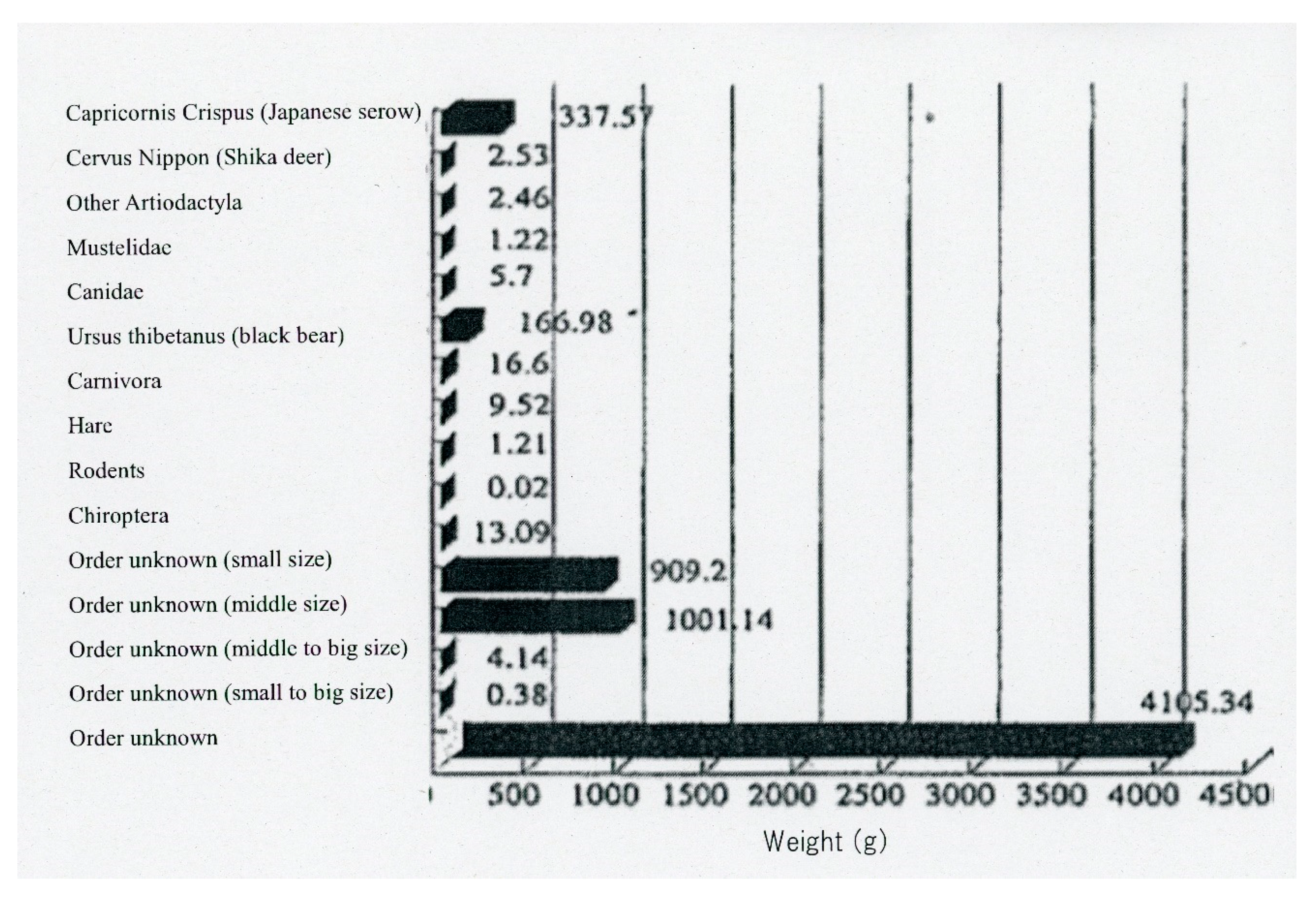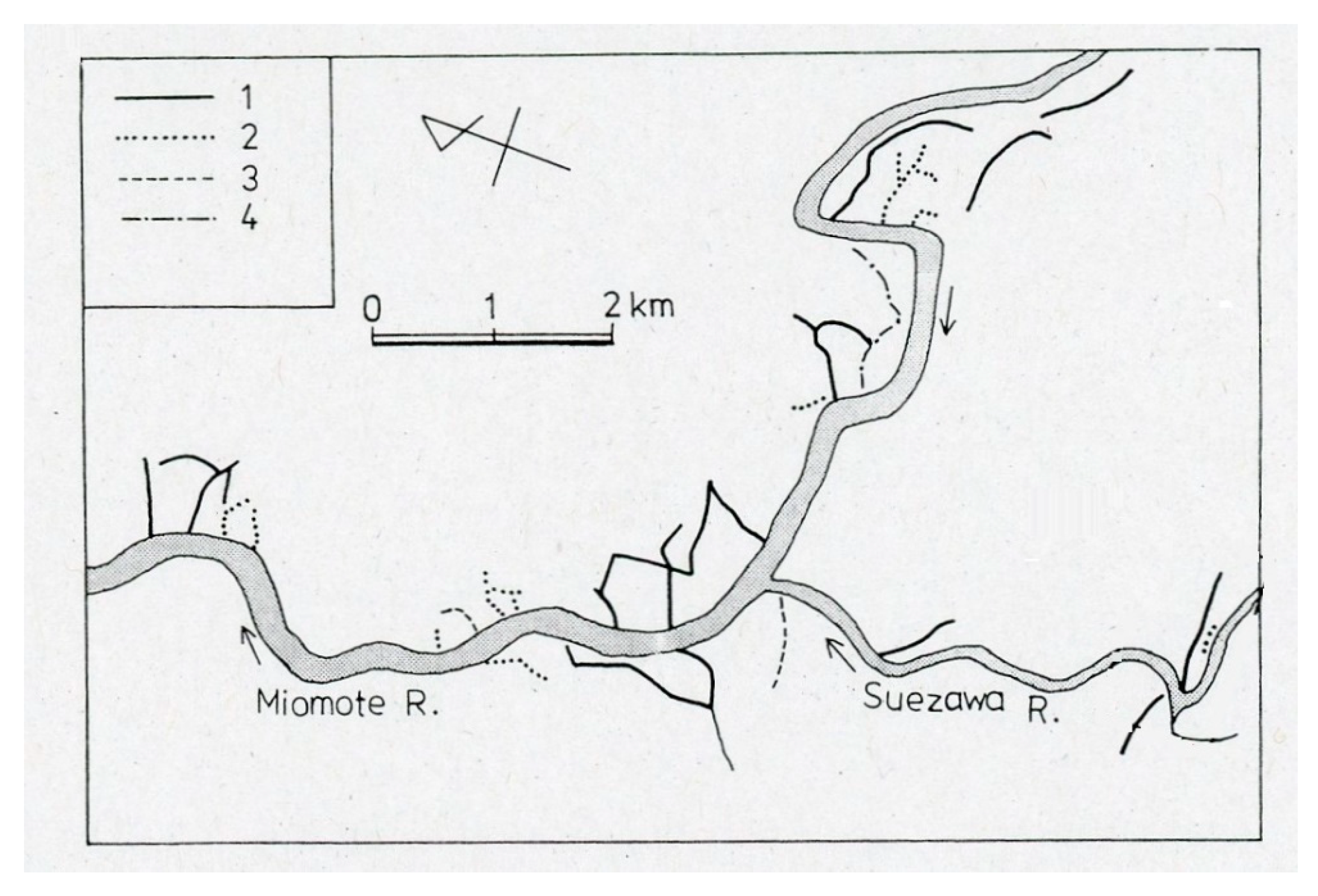Ethnoarchaeology of Introducing Agriculture and Social Continuity among Sedentarised Hunter–Gatherers: The Transition from the Jomon to the Yayoi Period
Abstract
:1. Introduction and Study Location
2. Theoretical Framework (Presumption): Transition from Jomon to Yayoi Period and Group Relationships
3. From Sedentarised Hunter-Gatherers to Early Farmers: Transition and Changes of Fusion Types C-1, C-2, and C-3
3.1. Combined Occupations of Sedentarised Hunter-Gatherers (C-1): Latter Half and Final Phase of the Jomon Period
3.2. Combined Occupations among Early Farmers (C-3): Early Edo Period (1655)
4. Results and Discussion: Establishment of Farming by Sedentarised Hunter-Gatherers and Social Continuity
Funding
Institutional Review Board Statement
Informed Consent Statement
Data Availability Statement
Acknowledgments
Conflicts of Interest
References
- Miyake, Y. Hunter-Gatherer Societies in the Prehistoric West Asia. In Global Environmental History from the Perspective of Hunter-Gatherers: Coexistence with Nature, Neighbors, and Civilization (Shuryo Saishumin kara mita Chikyu Kankyo-shi); Ikeya, K., Ed.; University of Tokyo Press: Tokyo, Japan, 2017; pp. 58–73. ISBN 978-4-13-060317-1. (In Japanese) [Google Scholar]
- Bar-Yosef, O.; Meadow, R.H. The Origins of Agriculture in the near East. In Last Hunters-First Farmers: New Perspective on the Prehistoric Transition to Agriculture; Price, T.D., Gebauer, B., Eds.; School of Advanced Research Press: Santa Fe, NM, USA, 1995; pp. 39–94. [Google Scholar]
- Fuller, D.Q.; Qin, L.; Zheng, Y.; Zhao, Z.; Chen, X.; Hosoya, L.A.; Sun, G.-P. The Domestication Process and Domestication Rate in Rice. Science 2009, 323, 1607–1610. [Google Scholar] [CrossRef] [PubMed] [Green Version]
- Habu, J. Ancient Jomon of Japan; Cambridge University Press: Cambridge, UK, 2004; ISBN 978-0521776707. [Google Scholar]
- Habu, J. Resource Use by Jomon People and Long-Term Changes of Their Culture. In Hunting-Gathering Culture in Japan (Nihon no Shuryo Saishu Bunka); Ikeya, K., Ed.; Sekaishiso-Sha: Kyoto, Japan, 2005; pp. 45–72. ISBN 978-4790711285. (In Japanese) [Google Scholar]
- Nasu, H. The Initial Form of Rice and Millet Cultivation during the Final Jomon-Yayoi Transition Era from the View of Archaeobotanical Weed Assemblages. Bull. Natl. Mus. Jpn. Hist. 2014, 187, 95–110. (In Japanese) [Google Scholar]
- Nasu, H.; Momohara, A. The Beginnings of Rice and Millet Agriculture in Prehistoric Japan. Quat. Int. 2016, 397, 504–512. [Google Scholar] [CrossRef]
- Fujio, S. History of Yayoi Period (Yayoi Jidai no Rekishi); Kodansha: Tokyo, Japan, 2015; ISBN 978-4062883306. (In Japanese) [Google Scholar]
- Shitara, H. From the Jomon Period to the Yayoi Period, Iwanami Lecture, Japanese History; Iwanami Shoten: Tokyo, Japan, 2013; Volume 1. (In Japanese) [Google Scholar]
- Fujio, S. Early Grain Cultivation and Starting Processes in the Japanese Archipelago. Quaternary 2021, 4, 3. [Google Scholar] [CrossRef]
- Fujio, S. The Formation of Yayoi Culture in Fukuoka Plain. Bull. Natl. Mus. Jpn. Hist. 1999, 77, 51–84. (In Japanese) [Google Scholar]
- Nakayama, S. Plant Archaeology and Origins of Japanese Agriculture (Shokubutsu Kokogaku to Nihon no Noko no Rekishi); Doseisha: Minato City, Tokyo, 2010. (In Japanese) [Google Scholar]
- Obata, H. Northeast Asian Paleoethnobotany and Jomon Agriculture (Touhoku Ajia Kominzoku Shokubutsugaku to Jomon Noko); Doseisha: Minato City, Tokyo, 2011. (In Japanese) [Google Scholar]
- Ikeya, K. Bear Ritual of the Matagi and the Ainu in Northeastern Japan. In Circumpolar Animism and Shamanism; Yamada, T., Irimoto, T., Eds.; Hokkaido University Press: Sapporo, Japan, 1997; pp. 55–63. [Google Scholar]
- Ikeya, K. Mobility and Territoriality among Hunting-Farming-Trading Societies: The Case Study of Bear Hunting in Mountain Environments of Northeastern Japan. In Beyond Affluent Foragers: Rethinking Hunter-Gatherer Complexity; Grier, C., Kim, J., Uchiyama, J., Eds.; Oxbow Books: Oxford, UK, 2006; pp. 34–44. [Google Scholar]
- Education Board of Asahi Village. Excavation Report of the Archeological Sites related to Okumiomote Dam Construction, IV (Okumiomote Dam kanren Iseki Hakkutsu Chosa Hokokusho 4), Motoyashiki Ruins; Education Board of Asahi Village: Murakami, Japan, 1995. (In Japanese) [Google Scholar]
- Yatsuka, H.; Ikeya, K. Farming Practices among African Hunter-Gatherers: Diversifying without Loss of the Past. In Rethinking African Agriculture: How Non-Agrarian Factors Shape Peasant Livelihoods; Hyden, G., Sugimura, K., Tsuruta, T., Eds.; Routledge, Taylor and Francis Group: London, UK, 2020; pp. 49–63. [Google Scholar]
- Ikeya, K. The Historical Dynamics of the Socioeconomic Relationships between the Nomadic San and the Rural Kgalagadi, Botswana. Notes Rec. 1999, 31, 19–32. [Google Scholar]
- Turnbull, C. The Forest People; Simon & Schuster: New York, NY, USA, 1961. [Google Scholar]
- Terashima, H. Economic Exchange and the Symbiotic Relationship between the Mbuti (Efe)Pygmies and the Neighbouring Farmers. Sprache Gesch. Afr. 1986, 7, 391–405. [Google Scholar]
- Headland, T.N.; Reid, L.A.; Bicchieri, M.G.; Bishop, C.A.; Blust, R.; Flanders, N.E.; Gardner, P.M.; Hutterer, K.L.; Marciniak, A.; Schroeder, R.F.; et al. Hunter-Gatherers and Their Neighbors from Prehistory to the Present [and Comments and Replies]. Curr. Anthropol. 1989, 30, 43–66. [Google Scholar] [CrossRef] [Green Version]
- Ikeya, K.; Nakai, S. Historical and Contemporary Relations between Mlabri and Hmong in Northern Thailand. In Senri Ethnological Studies 73 Interactions between Hunter-Gatherers and Farmers: From Prehistory to Present; Ikeya, K., Nakai, S., Eds.; National Museum of Ethnology: Osaka, Japan, 2009; pp. 247–261. [Google Scholar]
- Takeuchi, K. Interethnic Relationships between Pygmies and Farmers. In Hunter-Gatherers of the Congo Basin: Cultures, Histories, and Biology of African Pygmies; Hewlett, B.S., Ed.; Transaction Publishers: Piscataway Township, NJ, USA, 2014; pp. 299–320. ISBN 1412853613. [Google Scholar]
- Harunari, H. The Beginning of the Yayoi Period; Tokyo University Press: Tokyo, Japan, 1990; ISBN 978-4130241113. [Google Scholar]
- Fujio, S. Interaction between the Jomon Farmer and the Yayoi Farmer in the Beginning of the Yayoi Period along the Old Kawachi Lake. Bull. Natl. Mus. Jpn. Hist. 2009, 152, 373–400. (In Japanese) [Google Scholar]
- Ono, A. (Ed.) Choja-Iwaya Rock Shelter Site; Education Board of Asahi Village: Niigata Prefecture, Japan, 1993. (In Japanese) [Google Scholar]
- Education Board of Asahi Village. Excavation Report of the Archeological Sites Related to Okumiomote Dam Construction (Okumiomote Dam kanren Iseki Hakkutsu Chosa Hokokusho) XIV, Motoyashiki Site II Upper; Education Board of Asahi Village: Murakami, Japan, 2002. (In Japanese) [Google Scholar]
- Tomioka, N.; Asari, H. Analysis of Animal Remains Excavated from Motoyashiki Site in Niigata Prefecture. In Excavation Report of the Archeological Sites Related to Okumiomote Dam Construction (Okumiomote Dam kanren Iseki Hakkutsu Chosa Hokokusho) XIV, Motoyashiki Site II Upper; Education Board of Asahi Village: Murakami, Japan, 2002; pp. 334–340. (In Japanese) [Google Scholar]
- Education Board of Asahi Village. Excavation Report of the Archeological Sites related to Okumiomote Dam Construction, I(Okumiomote Dam kanren Iseki Hakkutsu Chosa Hokokusho 1), Shimozori Ruins; Education Board of Asahi Village: Niigata Prefecture, Japan, 1990. (In Japanese) [Google Scholar]
- Sato, Y. Castanea crenata and Its DNA Analysis Excavated from Motoyashiki Site in Niigata Prefecture Excavation Report of the Archeological Sites Related to Okumiomote Dam Construction (Okumiomote Dam kanren Iseki Hakkutsu Chosa Hokokusho)XIV, Motoyashiki Site II Upper; Education Board of Asahi Village: Niigata Prefecture, Japan, 2002; pp. 357–365. (In Japanese) [Google Scholar]
- Crawford, G.W. Advances in Understanding Early Agriculture in Japan. Curr. Anthropol. 2011, 52 (Suppl. 4), S331–S345. [Google Scholar] [CrossRef]
- Miyajima, H. Identification of Beads Excavated from the Motoyashiki Site. In Excavation Report of the Archeological Sites Related to Okumiomote Dam Construction (Okumiomote Dam kanren Iseki Hakkutsu Chosa Hokokusho) XIV, Motoyashiki Site II Upper; Education Board of Asahi Village: Murakami, Japan, 2002; pp. 414–418. (In Japanese) [Google Scholar]
- Watanabe, S. (Ed.) Okumiomote: A Mountain Village of Uetsu Boundary (Uetsu Kokkyo No Sanson Okumiomote); Yamagata Chiri-Danwakai: Yamagata, Japan, 1979. (In Japanese) [Google Scholar]
- Ikeya, K. Rice Crops and Shifting Cultivation in Miomote, Murakamihan in the Edo Era. Sci Rep. Tohoku Univ. 1987, 37, 41–51. [Google Scholar]
- Education Board of Asahi Village (Ed.) Folklore of Asahi Village (Asahi Mura No Minzoku) II; Education Board of Asahi Village: Murakami, Japan, 1984. (In Japanese) [Google Scholar]
- Ikeya, K. Social Monograph among Wild Plant Gatherers: Natural Resource Use and Territoriality (Sansai Torino Shakaishi-Shigen Riyo to Teritori); Tohoku University Press: Miyagi, Japan, 2003; ISBN 4-925085-75-1. (In Japanese) [Google Scholar]
- Kaner, S.; Yano, K. Early Agriculture in Japan. In The Cambridge World History; Barker, G., Ed.; Cambridge University Press: Cambridge, UK, 2015; pp. 353–386. [Google Scholar]
- Ikeya, K. Dry Farming among the San in the Central Kalahari. Afr. Study Monogr. Suppl. 1996, 22, 85–100. [Google Scholar]
- Ikeya, K. Environment and Resource Management among the San in Botswana. Nomadic Peoples 2001, 4, 67–82. [Google Scholar] [CrossRef]
- Yasumuro, S. Japanese Livelihood (Nihon Minzoku Nariwai Ron); Keiyusha: Tokyo, Japan, 2012; ISBN 978-4-87449-093-8. (In Japanese) [Google Scholar]









Publisher’s Note: MDPI stays neutral with regard to jurisdictional claims in published maps and institutional affiliations. |
© 2021 by the author. Licensee MDPI, Basel, Switzerland. This article is an open access article distributed under the terms and conditions of the Creative Commons Attribution (CC BY) license (https://creativecommons.org/licenses/by/4.0/).
Share and Cite
Ikeya, K. Ethnoarchaeology of Introducing Agriculture and Social Continuity among Sedentarised Hunter–Gatherers: The Transition from the Jomon to the Yayoi Period. Quaternary 2021, 4, 28. https://0-doi-org.brum.beds.ac.uk/10.3390/quat4030028
Ikeya K. Ethnoarchaeology of Introducing Agriculture and Social Continuity among Sedentarised Hunter–Gatherers: The Transition from the Jomon to the Yayoi Period. Quaternary. 2021; 4(3):28. https://0-doi-org.brum.beds.ac.uk/10.3390/quat4030028
Chicago/Turabian StyleIkeya, Kazunobu. 2021. "Ethnoarchaeology of Introducing Agriculture and Social Continuity among Sedentarised Hunter–Gatherers: The Transition from the Jomon to the Yayoi Period" Quaternary 4, no. 3: 28. https://0-doi-org.brum.beds.ac.uk/10.3390/quat4030028






